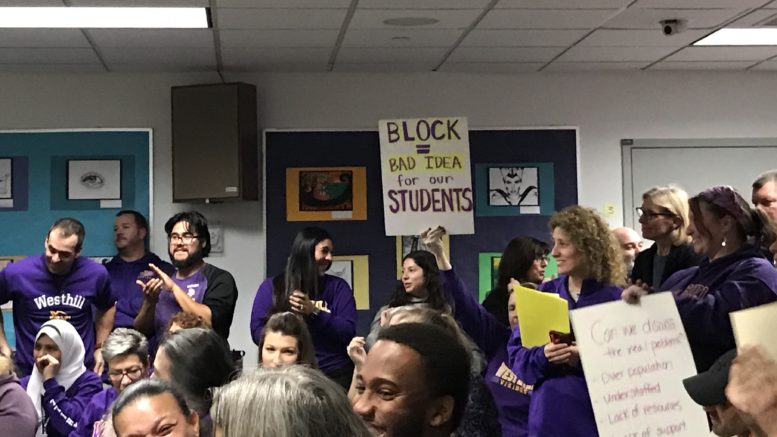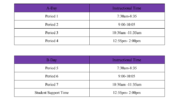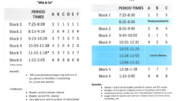In the past, The Westword Online has refrained from posting editorials online. However, next year’s schedule has been frequently discussed among the Westhill population as students and teachers have begun to question its justification and their voices in the decision. We intend to continue to post editorials in order to provide relevant media for the Westhill community.
Westhill’s move to block scheduling has been omnipresent for a few years now, with many rumors looming and a lack of fundamental information. The week of December 6, the new schedule was confirmed, a decision greatly against the wishes of students and faculty.
Despite students being impacted most by this change, they have been the least informed on the issue. This has created immense confusion around the issue overall. It is just in these last few months that students are coming into the know enough to develop their own opinions on the issue.
The student consensus has been pretty definite, and the large majority of Westhill students do not support this move. In addition to a lack of information, the implementation of block scheduling is laden with drastic implications, flawed reasoning, and poor planning.
Word of a block schedule has been circulating since the 2017-2018 school year, but its future was not set in stone. The plan has allegedly been in the making since 2016, the schedule having been drafted to mirror that of AITE: four 88-minute periods each day. It was designed to mimic college-length courses and to provide students and teachers with longer periods to hopefully get more done.
The teachers and students who were against the block scheduling at the time breathed a sigh of relief when it was decided that it would not be implemented in the 2019-2020 school year, but the Board of Education (BOE) has been making strides towards block scheduling in the upcoming school year.
According to Mr. Rinaldi, he along with Principal Manka of Stamford High School had been briefed regarding the new schedule, which they had then relayed to their staff. However, at the BOE meeting a few weeks later it was announced that educators would likely be required to teach a six-period day, blindsiding all faculty members attending the meeting.
“This [the change in the plan] was going to blow up. We did not tell the teachers that, we knew there would be backlash,” Mr. Rinaldi said.
On November 23, the BOE, teachers, students, parents, and even custodians met to discuss the new schedule and its implications. All of the 28 speakers expressed their disfavor of the block scheduling.
The following day, the BOE sent out an email detailing the new schedule and plan for the 2020-2021 school year.
The primary motivation for this change was the state’s move to a 25 credit graduation requirement, a change from the current 20 credit requirement. Therefore, more periods in “theory” should make graduation more likely and increase district rates.
The BOE has neglected to account for the student voice on block scheduling.
At the November BOE meeting, the board responded to the student opinions by sitting on their phones and not responding to student concerns. Without a social media platform, reaching the BOE is a challenge, therefore not many students reach out directly. As a result, the student voice is not touched upon publically, and is only being addressed behind closed doors with specific students who have contacted the BOE.
Many students have responded with disagreement regarding the block scheduling decision for the 2020-2021 school year, however, the BOE has not taken the opinions of the students seriously.
“The fact that students are being left out of the conversation about block scheduling is honestly a failure of the school system in general,” Divya Gada (’20) said. “I personally feel as though the school board is taking very serious decisions too lightly. In the end, the students will be impacted the most by the change to block scheduling but the board fails to notice that. The board is refusing to speak to the people who will be impacted the most.”
The notion of block scheduling and what it entails being harmful to adolescents is not merely a matter of student opinion: it is a fact of neuroscience.
According to The Guardian, youths have consistently higher stimulation of the prefrontal cortex compared to developed brains. Additionally, a study performed by neuroscientist Dr. Michael Halassa indicates that the prefrontal cortex needs to be functioning smoothly alongside the thalamic reticular nucleus in order for the brain to efficiently process sensory information. In other words, the prefrontal cortex is necessary to be able to focus on tasks, and it is not developed until after the teenage years. Due to the stimulation of the prefrontal cortex, the brain struggles to filter out irrelevant stimulation, causing adolescents to be easily distracted. Therefore it is unjust that adults would mandate class lengths which adolescent brains are not equipped to deal with.
According ascd.org, interspersed breaks revive student attention span, especially if these breaks are somewhat active. This means that changing classes multiple times gives students the chance to take in more information, since movement between classes refreshes their ability to process information. Block scheduling promises to remove many of these imperative breaks.
“Block scheduling is not a good idea because I have a very short attention span and I have trouble paying attention in even 50-minute classes so it is going to be really hard for people like me to pay attention for that long,” Ellie Balestriere (’20) said. “If you miss school you are missing so much more, and if a teacher misses school the class becomes very behind. You miss out on three full days of teaching and instruction.”
The BOE claims that having three passing times throughout the day instead of five will reduce fights. However, fights are still a problem at schools that have instituted block scheduling such as Danbury, Norwalk, and AITE. Students who choose to fight will not stop fighting solely due to there being less passing time. Fighting is a disciplinary problem; reducing the number of passing times is not a solution to this.
When we spoke with Mr. Rinaldi, he cited the implementation at the other schools he had visited as a comparable source of consolation for how effective implementation of a block schedule would be at Westhill.
Nevertheless, the consensus on block scheduling at those schools is complicated.
In discussing their block scheduling with students at AITE, as well as at Norwalk and Danbury High, they highlighted issues with the schedule including rushed courses due to decreased instruction time, as well as how much one can miss in a class if they are out due to the extended period length.
“Personally, I feel like I do miss out on a lot, especially in math and AP classes because they tend to move fast,” Emily Lopez (’21) a student at AITE, said.
One of the BOE’s reasons for implementing the block schedule is the intention to increase the competitiveness of students from Stamford Public Schools applying to college.
This is based on the Board’s understanding that with an eight period schedule, students would have the opportunity to take more high level courses during their time in high school.
However, the way the college application process works is that schools take students into consideration based on the availability within their schedule and course offerings. As a result, the proposed schedule would force students who want to go to some of the top colleges in the country to take an extra AP class each year in order to meet high standards. This, therefore, only exacerbates the current issue of overstressed students and makes it harder for them to appear as a competitive applicant.
Another enormous implication of block scheduling is the decreased overall instruction time. The current estimate is that with next year’s proposed schedule, teachers would lose an average of 12 and a half hours per course each year.
Not only does this mean that the same material will have to be covered in less time, but it would also be particularly tough for AP classes. Already crunched for time to finish curricula for the exam in May, teachers have to jam their teaching into even less time with the block schedule. Teachers were not consulted in the development of the new schedule, and have serious concerns about its implementation.
“We cannot take our current lesson plans and ‘drop’ them as doubles into blocks, because they would not fit this model. So what do we cut, from our district curriculum and our College Board approved AP curriculum?” Ms. Tobin and Ms. Berkley said in their Op-Ed for The Stamford Advocate.
Not to mention, the continuity between teaching is also disturbed given that students only have classes every other day. Much of the teachers’ frustration over the block scheduling plan is that the BOE failed to consult any educators in the process of designing the plan. As a result, it is not meeting student needs.
“It just will not work, the kids will not be able to focus and will not retain much information and then losing time, in the end, does not really equate to having more classes,” Austin Tovar (’22) said.
Overall, the institution of block scheduling in Stamford has many negative consequences for those most directly affected, the SPS students. The Board of Education’s poor reasoning for implementing the new schedule in addition to the failure to take student and teacher opinions into consideration is going to result in many problems for the district.





